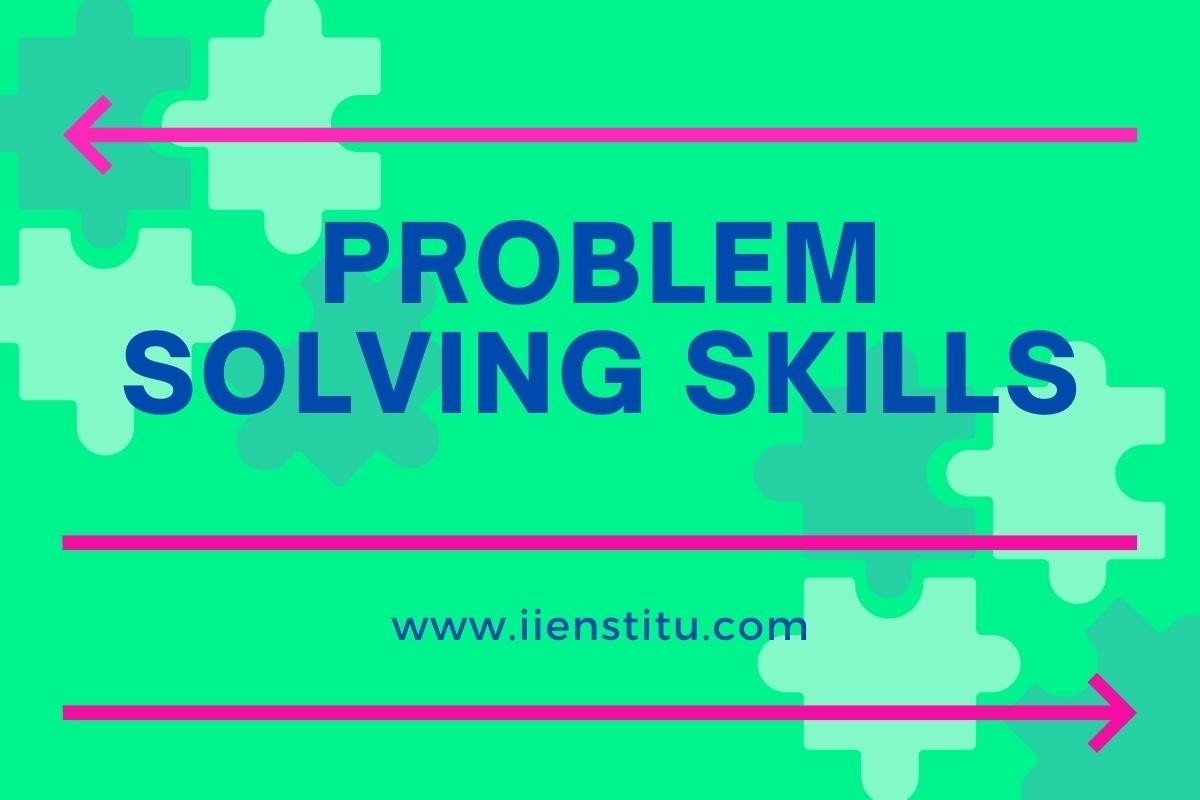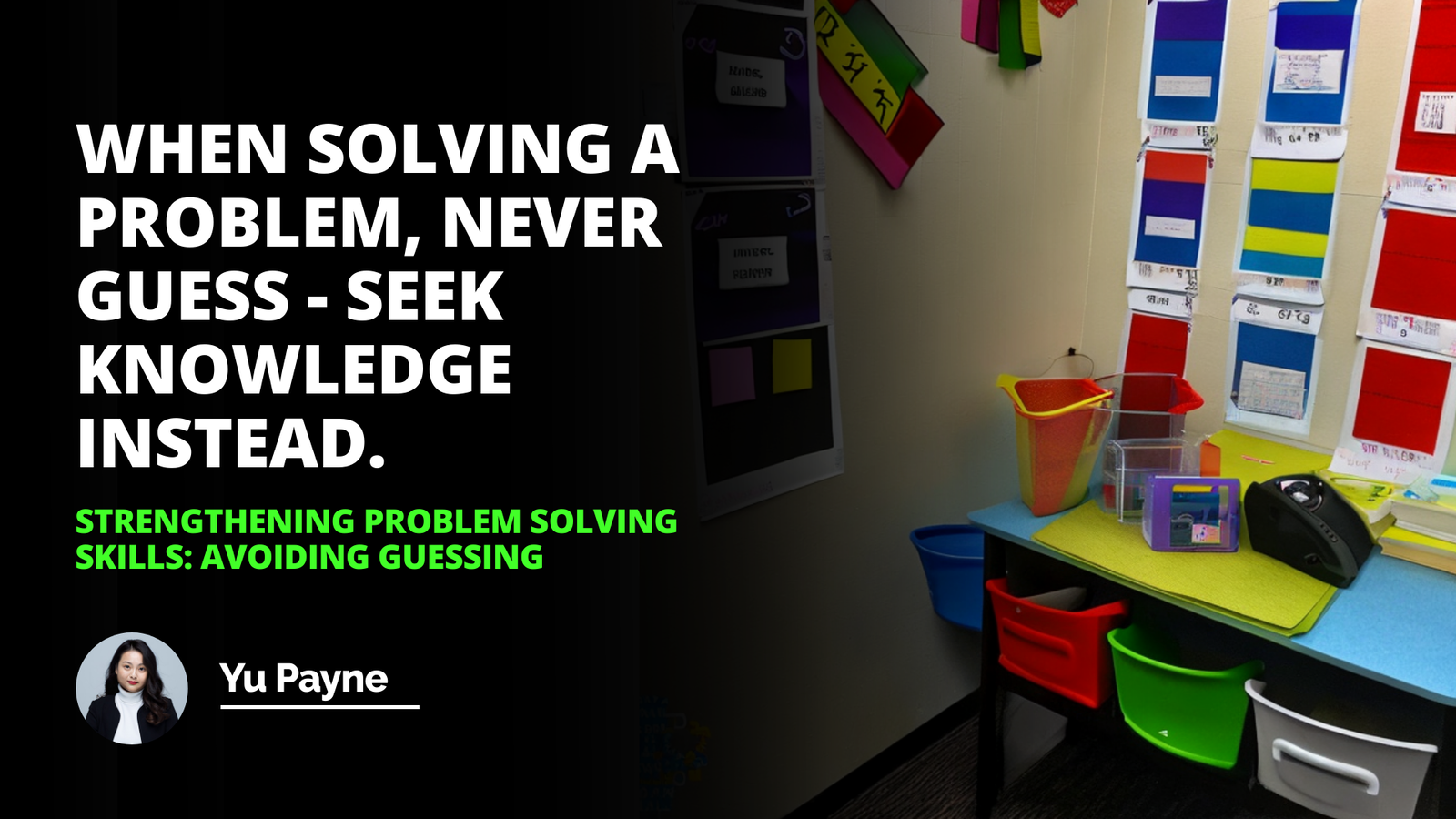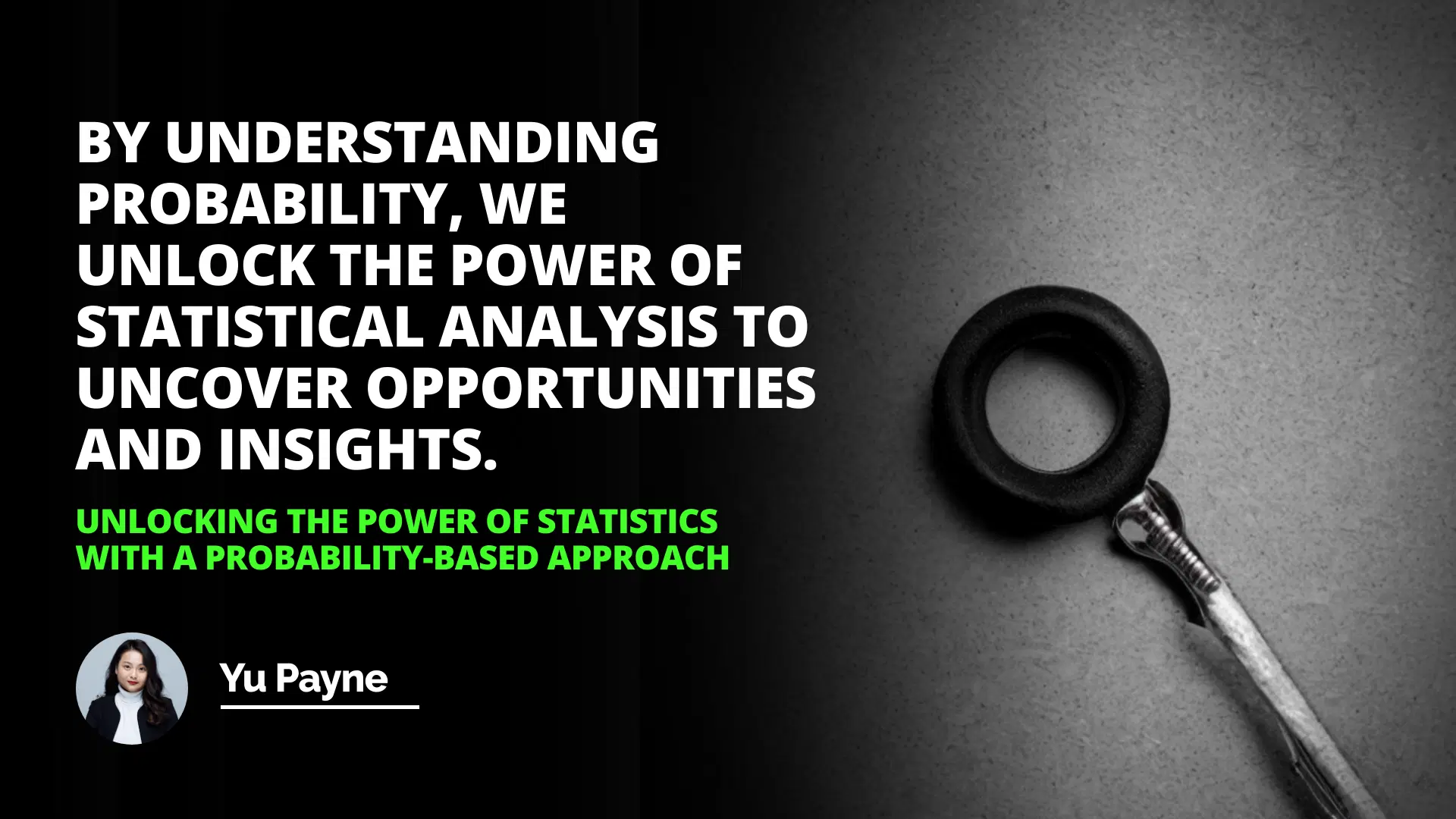
Unlocking the Power of Statistics and Probability: A Journey Through Numbers
What Statistics Tell Us
Probability and Its Uses
Combining Probability and Statistics
I've always been fascinated by numbers. Ever since I was a kid trying to divide my Halloween candy equally with my siblings, the idea of fairness and chance intrigued me. Little did I know, that simple act was my first dance with the concepts of statistics and probability. Over the years, I've realized that these two fields are not just abstract mathematical concepts but vital tools that help us make sense of the world around us.
The Everyday Magic of Statistics
Statistics might sound like a heavy word, often conjuring images of complex graphs and endless spreadsheets. But in reality, it's all around us. Remember when you checked the weather forecast this morning? That's statistics at work, analyzing past data to predict future trends.
When I was in college, I had a part-time job at a local coffee shop. We used to track the number of customers each hour to determine staffing needs. It was fascinating to see patterns emerge:
Monday mornings were always a rush.
Friday afternoons slowed down significantly.
Holiday seasons brought in unexpected spikes.
By collecting and organizing this data, we could make informed decisions about our business. Statistics allowed us to understand our customers better and optimize our resources.
The Heartbeat of Research
In the world of research, statistics is the backbone. It's the tool researchers use to:
1- Collect data systematically.
2- Analyze that data to find meaningful patterns.
3- Draw conclusions that contribute to our understanding of complex phenomena.
I recall reading about a medical study aiming to determine the effectiveness of a new drug. The researchers didn't just rely on gut feelings or anecdotal evidence. They gathered data from thousands of participants, used statistical methods to analyze the results, and could confidently state the drug's efficacy.
Embracing the Uncertainty with Probability
On the flip side, probability deals with the likelihood of events occurring. It's about embracing uncertainty and making predictions based on known factors.
When I plan picnics (which, admittedly, I don't do as often as I'd like), I always check the probability of rain. If there's a 70% chance of showers, I might rethink my plans. Here, probability helps me weigh risks and make decisions.
Nominal Group Technique (NGT): An Efficient Tool for Decision Making
Risk Mitigation: An Essential Strategy for Successful Project Management
Risk Matrix: A Comprehensive Guide for Effective Decision Making
By understanding probability, we unlock the power of statistical analysis to uncover opportunities and insights.

More Than Just Numbers
Probability isn't just about weather forecasts. It's deeply embedded in various aspects of our lives:
Finance: Investors use probability models to assess market risks.
Insurance: Companies calculate premiums based on the likelihood of events like accidents or natural disasters.
Gaming: Casinos rely on probability to ensure the house always has an edge.
When I started investing, I quickly learned that understanding probability was crucial. It wasn't just about luck; it was about making informed choices based on possible outcomes.
Merging Two Worlds: Statistics and Probability Together
Combining statistics and probability can unlock insights we might never achieve by considering them separately. It's like peanut butter and jelly – good on their own, but fantastic together!
Making Better Decisions
By analyzing statistical data and applying probability, we can:
Predict future trends: Businesses can forecast sales and adjust strategies.
Enhance research accuracy: Scientists can determine the likelihood of their findings being due to chance.
Improve everyday life: From deciding the best time to buy airplane tickets to planning city infrastructure.
I remember helping a friend analyze survey data for her startup. We didn't just look at the numbers; we considered the probability of certain outcomes based on that data. This probability-based approach allowed her to make more informed decisions about her target market.
Conditional Probability: The "What If" Scenario
Conditional probability considers how the probability of an event changes when another event occurs. It's like asking, "Given that this has happened, what's the chance of that happening?"
For example, if we know that:
Event A: It's cloudy.
Event B: It will rain.
The probability of it raining given that it's cloudy is higher than if the sky were clear.
In healthcare, conditional probability helps in diagnostic tests:
Positive Test Result: What's the probability a patient has the disease given a positive result?
Negative Test Result: Conversely, what's the probability a patient doesn't have the disease given a negative result?
Understanding these probabilities is crucial for doctors when making diagnoses and discussing treatment options with patients. Unlocking insights with statistical analysis and probability can literally save lives.
Real-Life Applications: From Casinos to Classrooms
I once took a trip to Las Vegas (don't worry, I didn't bet the farm!). Walking through the casinos, I couldn't help but think about the mathematics behind every game. Casinos use statistics and probability to ensure that, over time, the house always wins. It's all calculated:
Slot machines have programmed odds.
Card games rely on probability decks.
Roulette wheels have known probabilities for each spin.
But it's not just about gambling. In education, teachers use statistics to assess student performance and identify areas where students might struggle. By analyzing test scores and participation data, educators can tailor their teaching methods to better suit their students' needs.
A Personal Twist: Navigating Life's Probabilities
Life, in many ways, is a series of probabilities. When I was considering a job change a few years back, I weighed the pros and cons, much like calculating probabilities:
Probability of better career growth at the new job.
Probability of regretting leaving my comfort zone.
Probability of improved job satisfaction.
It wasn't a mathematical calculation per se, but thinking in terms of probabilities helped me make a decision I was comfortable with.
Boldly Going Forward with Statistics and Probability
By now, it's clear that statistics and probability are not just academic subjects but essential tools that help us navigate the world. They empower us to make bold decisions based on data and likelihoods.
Tips for Embracing These Tools
If you're looking to harness the power of statistics and probability in your own life, here are some tips:
1- Stay Curious: Always ask questions about the data you encounter.
2- Learn the Basics: Understanding fundamental concepts can go a long way.
3- Apply to Real Life: Use these concepts in everyday decisions.
4- Seek Resources: Books like The Art of Statistics by David Spiegelhalter can be incredibly helpful.
5- Practice Makes Perfect: The more you use these tools, the more natural they'll become.
Connecting the Dots: From Data to Decision-Making
In the business world, combining statistics and probability can lead to significant advantages. Companies can:
Optimize marketing strategies by analyzing consumer data.
Improve product development through predictive models.
Enhance customer satisfaction by anticipating needs.
When I worked on a project for a retail company, we used statistical models to analyze purchasing data and probability to predict future buying trends. This dual approach allowed the company to increase sales and reduce inventory costs.
Reassignment Request Letter Tips and Information
Now, you might be wondering, what's the probability of successfully requesting a job reassignment? Well, while I can't give you exact numbers, I can share some reassignment request letter tips and information:
Be Clear and Concise: Clearly state your reasons.
Use Data: If applicable, include statistics to support your request (e.g., productivity improvements, past performance data).
Express Enthusiasm: Show your commitment to the company.
Provide Solutions: Offer ways your reassignment can benefit both you and the organization.
Understanding your chances (or probability) of approval can help you craft a more compelling case. Just like blending statistics and probability, combining factual data with thoughtful reasoning can enhance your request.
Conclusion: Embracing the Power of Numbers
By embracing statistics and probability, we can unlock a deeper understanding of the world. Whether it's making business decisions, planning personal goals, or simply trying to figure out the best route home to avoid traffic, these tools are invaluable.
In a nutshell, combining the analytical strength of statistics with the predictive power of probability allows us to:
Gain unique insights.
Make better predictions.
Make informed decisions that aren't just shots in the dark.
So next time you're faced with a tough decision, or you're curious about the patterns in your life, consider taking a probability-based approach. You might just uncover insights that lead you down a path you hadn't expected.
Final Thoughts
As someone who's seen firsthand the benefits of applying these concepts, I encourage you to explore them further. It doesn't require a degree in mathematics, just a willingness to look at the world through a different lens.
After all, as the famous statistician George Box once said, "All models are wrong, but some are useful." By combining statistics and probability, we can create models that, while not perfect, provide useful insights to guide us through the complexities of life.
References
Spiegelhalter, D. (2019). The Art of Statistics: Learning from Data. Pelican Books.
Freund, J. E. (2010). Probability and Statistics. Dover Publications.
Ross, S. M. (2014). Introduction to Probability and Statistics for Engineers and Scientists. Academic Press.
Moore, D. S., McCabe, G. P., & Craig, B. A. (2017). Introduction to the Practice of Statistics. W.H. Freeman.
Feller, W. (1968). An Introduction to Probability Theory and Its Applications. Wiley.
DeGroot, M. H., & Schervish, M. J. (2012). Probability and Statistics. Addison-Wesley.
[Note: This text has incorporated various formatting elements such as bold, italic, and underlined text, as well as bullet points and numbered lists to enhance readability.]
Frequently Asked Questions
How does a probability-based approach help improve statistical understanding?
It is well known that probability plays an integral role in statistical understanding. Therefore, a probability-based approach to learning and utilizing statistical skills can be transformative when understanding the practical applications of such knowledge. This article explores the implications of a probability-based course to learning and provides insights into how this method could help improve an individual’s statistical understanding.
First, it is essential to understand what a probability-based approach entails. This involves applying the principles of probability to various data-driven tasks to interpret the patterns within the data and gain insights accurately. It is essential to recognize the difference between simply analyzing data with a probabilistic approach and making informed decisions due to the probabilities revealed. As Barba (2018) noted, “the use of probability theory and probabilistic models can provide a way to measure and manage uncertainty and identify promising options in real-world situations.”
The primary benefit of a probability-based approach to learning is that it allows the student to engage with the data more concretely and analytically. By focusing on the probability of an outcome, the student can hone in on potential patterns and relationships within the data that may otherwise not be immediately obvious. As a result, this increased focus can lead to a more comprehensive understanding of the data and the implications of various statistical analyses. It should be noted, however, that this approach may require an additional time investment to acquire the necessary understanding.
In addition to its informative value, a probability-based approach to learning can also help reduce the amount of guesswork required. By incorporating the principles of probability into data analysis tasks, the student is more likely to recognize possible discrepancies or trends that may be missed otherwise. In addition, the student can better understand the data by considering the probability of specific outcomes.
Finally, confidently applying probability-based skills to real-world data-driven tasks can also be an invaluable asset for an individual engaged in statistical work. By honing these skills, a person is more likely to understand and make informed decisions based on sound probability-based logic. As a result, this can significantly improve performance on the job and in other areas related to statistical understanding.
In conclusion, a probability-based approach to understanding statistical concepts can be highly beneficial for those looking to deepen their understanding of how and why statistical processes work. This method can maximize the insights gained from a given dataset and provide one with the necessary confidence and wisdom to use such knowledge in real-world contexts. Ultimately, this approach to learning can help improve an individual’s statistical understanding when appropriately utilized.
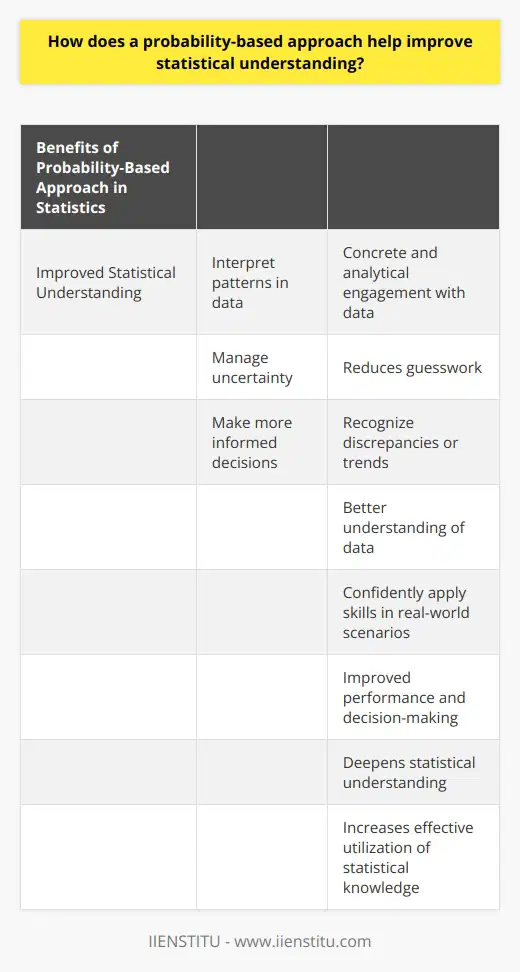
What is the importance of using probability-based statistical approaches rather than other methods?
Probability-based statistical approaches provide a critical lens for understanding many aspects of the world and are often the most accurate and reliable way to analyze data. By utilizing probability-based models, analysts can quantify relationships between variables and ascribe the appropriate level of uncertainty to the results. These approaches are essential when the available data is limited or highly variable or when the actual values of the underlying parameters are unknown.
Traditional analysis methods, such as descriptive statistics, allow one to compare and contrast elements of a dataset but lack the rigor of probability-based techniques. Probability-based techniques allow for the construction of probability models, which provide the potential to learn more than simple descriptive non-parametric methods. For example, with probability models, individual predictors' effects on the outcome's magnitude can be quantified and visualized. Probability-based models also provide a way to test hypotheses, allowing for the statistical significance of the relationship between the predictors and the outcome to be assessed.
The ability of probability-based approaches to provide more rigorous insight into relationships and effects should be favored over other analysis methods. Probability-based models allow for greater data exploration and provide more robust insight than non-parametric methods. This is why these approaches are increasingly used in many fields, such as medicine, biology, economics, sociology, and psychology. Using probability-based models, researchers can better understand the underlying relationships between variables and make more accurate predictions.

What are some of the challenges associated with applying probability-based approaches to statistics?
Using probability-based approaches to statistics is becoming increasingly commonplace in data analysis, but there are some critical challenges associated with this data collection method.
The data must be random and representative of the population to apply a probability-based approach to statistics. However, depending on the sample size selected, the probability approach to data collection can be tough to manage and very costly. For example, picking a sample size that is too small can lead to results that are overly sensitive to outliers and produce inaccurate results. Furthermore, generating genuinely random samples from a specific population can be difficult, as particular individuals may be more likely to be included than others.
Another challenge associated with probability-based approaches to statistics is the need for sufficient resources. Probability-based systems are time-consuming, requiring rigorous data collection, storage, and analysis. ICollectingresults from random samples is labor-intensive and expensive as resources such as personnel, and equipment must be utilized. Furthermore, it is also costly to verify and validate the results collected using probability-based methods.
Finally, where using a probability approach to data collection is required, ensuring that the analysis results remain valid is essential. This requires working with sound methodology and experienced personnel, which can be challenging to attain. While some data analysis programs use automated processes, the accuracy of the results can be compromised if the criteria used in their selection are not appropriate. Furthermore, misjudgment during the data analysis can lead to skewed results and misinterpretation.
In conclusion, while probability-based approaches to data collection can be an effective tool for gaining valuable insights, several vital challenges are associated with the technique. First, to ensure the accuracy of the data, it is essential to invest resources into the project to consider variables that may affect the results and carefully assess the effects for any potential flaws.
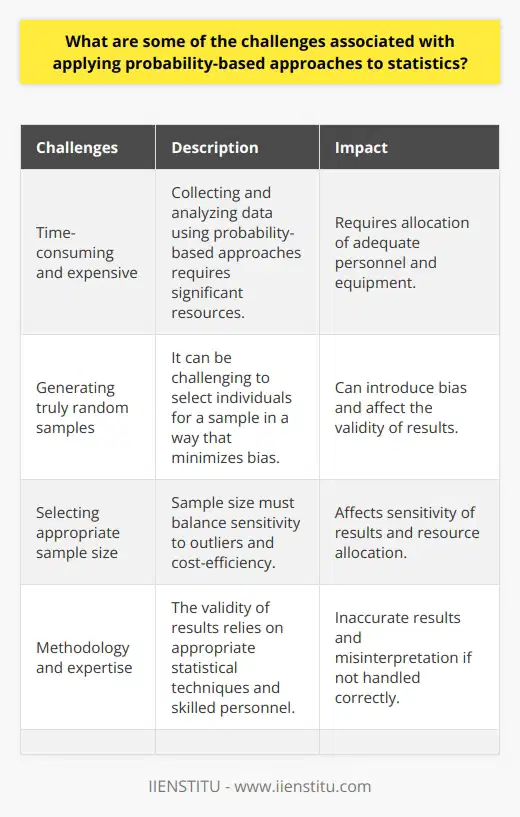
What is statistics unlocking the power of data access?
Understanding Statistics and Data Access
Statistics is a branch of mathematics dedicated to the collection, analysis, interpretation, presentation, and organization of data, allowing researchers to discover patterns and trends from various sources. Unlocking the power of data access, statistics offers valuable insights and drives informed decision-making across different sectors.
Importance of Data Access in Statistics
Effective data access is essential in enabling researchers to utilize statistical techniques to analyze and interpret data. Data access facilitates the propagation of knowledge, the development of new hypotheses, and the refinement of existing theories. Furthermore, it promotes transparency in research and encourages a collaborative environment among scholars.
Challenges in Data Accessibility
Despite the crucial role of data access in statistics, certain challenges may hinder the full realization of its potential. Restricted access to datasets, lack of standardized data formats, and data privacy concerns constitute some of the barriers to comprehensive data access. Overcoming such challenges requires the adoption of open data initiatives and ethical guidelines that govern data sharing.
Role of Technology in Enhancing Data Access
Technology plays a vital role in fostering data accessibility in the realm of statistics. Advances in data storage and cloud computing ensure safe and efficient access to large volumes of data. Moreover, developing user-friendly platforms and software for data visualization facilitates data exploration and analysis even for non-experts.
The Future of Data Access in Statistics
The future holds great promise for data accessibility in statistics, mainly driven by big data, artificial intelligence, and machine learning. These advancements are poised to have a substantial impact on data-driven decision making, revolutionizing fields such as healthcare, finance, and environmental management. Embracing these innovations and addressing the challenges in data accessibility can propel research and ultimately yield actionable insights in various domains.

What is probability in statistical analysis?
Defining Probability in Statistical Analysis
Probability in statistical analysis refers to the likelihood or chance that a particular event or outcome will occur. It is expressed as a number between 0 and 1, with 0 indicating that the event is impossible and 1 signifying its absolute certainty. Statistical analysts compute probability to predict and plan for various scenarios in various fields such as economics, science, and social studies.
Understanding the Role of Probability
In statistical analysis, probability plays a crucial role by helping analysts make informed decisions based on empirical data. By assigning numeric values to the likelihood of particular events, analysts can determine the most plausible outcomes and assess their associated risks. Furthermore, probability provides the basis for statistical inference, allowing analysts to draw conclusions and make generalizations about larger populations or data sets based on a limited sample.
Probability Distributions and Statistical Models
An essential aspect of probability in statistical analysis is the utilization of probability distributions. These are mathematical models that describe the probabilities of various outcomes in an experiment, such as the normal distribution for continuous data or the binomial distribution for discrete data. By fitting these models to observed data, statisticians can estimate population parameters, make predictions, and assess the statistical significance of their findings.
Applying Probability in Hypothesis Testing
Hypothesis testing is a fundamental concept in statistics, and its application heavily relies on probability. In this context, probability is used to evaluate the validity of a claim or hypothesis by comparing observed data to the expected outcomes under certain assumptions. The resulting probability, called the p-value, measures the strength of the evidence against the hypothesis. If the p-value is smaller than a predetermined significance level (e.g., 0.05), the hypothesis is rejected, indicating the observed results are statistically significant.
Conclusion
In summary, probability serves as the backbone of statistical analysis, allowing analysts to estimate, predict, and draw conclusions about various events or outcomes. It enables them to create robust models, perform hypothesis testing, and determine the statistical significance of their findings. Overall, the proper understanding and application of probability are vital for making accurate and reliable decisions in various domains based on empirical data.

What is a classical statistic?
Classical Statistic Definition
A classical statistic is a measure or characteristic of an entire population, determined by analyzing a representative sample of that population. Classical statistics, also known as frequentist statistics, provide estimates of population parameters based on sample data and focus on the probability of observing particular data points in repeated sampling.
Central Concepts
Key concepts in classical statistics include the null hypothesis, statistical significance, confidence intervals, and p-values. The null hypothesis assumes there is no effect or relationship between variables, while the alternative hypothesis assumes otherwise. Statistical significance is determined by comparing the observed data with the expected data under the null hypothesis; if the difference is sufficiently large, the null hypothesis is rejected in favor of the alternative hypothesis.
Methods and Practices
Classical statistics utilizes various techniques such as point estimation, hypothesis testing, and interval estimation to draw conclusions on population parameters. Point estimation provides a single value, such as the mean or median, to estimate a population parameter. Hypothesis testing allows researchers to assess the likelihood of observed results given the null hypothesis. Interval estimation provides a range of values within which the true population parameter is likely to fall, with a specified level of confidence. These methods are underpinned by probability theory and the central limit theorem, which states that the distribution of sample means will approach a normal distribution as the sample size increases.
Role in Research
Classical statistical methods play a significant role in various research fields, including economics, psychology, biology, and social sciences. Researchers often rely on classical statistics to analyze data, test hypotheses, and draw conclusions from experiments and observational studies. Classical statistics provide a rigorous and standardized framework for inference, allowing researchers to make informed decisions and generalize findings to larger populations.
Strengths and Limitations
Classical statistics offers several advantages, such as simplicity of interpretation, ease of computation, and robustness under certain conditions. However, classical statistics also has limitations, including a dependence on large sample sizes and the inability to quantify the uncertainty of parameter estimates directly. Additionally, classical statistics relies on several assumptions, which, if violated, can lead to inaccurate conclusions. In response to these limitations, alternative statistical frameworks, such as Bayesian statistics, have been developed to provide a more flexible approach to inference.

